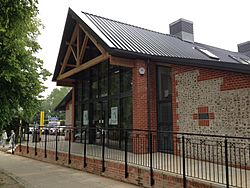Arundel Museum facts for kids

Arundel Museum
|
|
| Lua error in Module:Location_map at line 420: attempt to index field 'wikibase' (a nil value). | |
| Established | 1964 |
|---|---|
| Type | Archaeology, Social History and Geology |
Arundel Museum is a local museum that tells the story of the town of Arundel in West Sussex, England. It is run by the Arundel Museum Society, which is a registered charity. This means the museum is not for profit.
The museum is special because it is run by volunteers. It depends on money from members, donations, and special events to keep going and share Arundel's history with visitors.
Contents
The Museum's Journey Through Time
The Arundel Museum has moved several times since it first opened. Each location has been an important part of its story.
A Small Start in a Town Hall
The Arundel Museum Society was started in 1963 by local people who wanted to protect the town's history. At the time, old buildings and objects were at risk of being lost. The group wanted to save and display items from Arundel's past.
In March 1964, they opened their first museum. It was located in the old prison cells underneath the Arundel Town Hall. While this was an interesting place, it was also small and damp. The museum was run entirely by volunteers and was one of the first of its kind in the area.
Moving to the High Street
In 1975, the museum got a chance to move. The old council offices at 61 High Street became available. The local government, called Arun District Council, offered the building to the Museum Society.
The Society turned the historic building into a new museum, which opened in 1977. It grew to have eight different galleries. During this time, the museum worked hard to meet national standards for taking care of historical items. It was one of the first local museums to be officially registered for its good work.
The museum also started new projects. Volunteers collected stories from local people and published them in a book called Arundel Voices. They also created a town walking trail and an art gallery for special exhibitions.
Facing an Uncertain Future
After the year 2000, the museum's future became uncertain. The council planned to sell the building on High Street, so the museum had to find a new home.
In 2007, the museum had to move out. Volunteers carefully packed up every single item in the collection and put them into storage. For a few years, the museum operated from temporary buildings so it could stay open for visitors.
A New Home for the Museum
In 2008, two local estates offered the museum a perfect spot for a new, permanent building. The site was right in the center of town, opposite the castle gate. This was a huge step forward.
The Museum Society now had two big goals:
- Design a brand-new museum building.
- Raise £1.6 million to build it.
The society applied for a large grant from the National Lottery Heritage Fund. Their first application was successful, which allowed them to create detailed plans. In 2011, they received the fantastic news that they had been awarded a grant of £888,000.
With this money, plus funds from the Arun District Council and local fundraising, they had enough to start building. Construction began in early 2012.
The Museum Today
The beautiful new museum building, located next to the river, was officially opened on June 24, 2013. It stands opposite the Lower Castle Gate and welcomes visitors who want to explore the rich history of Arundel.
See also

